Sourdough Sandwich Bread with a Soft Crust
Sourdough Sandwich Bread is made with milk, butter & active sourdough starter. This soft crust sourdough bread has a tender crumb and awesome flavor. It makes a perfect sandwich.
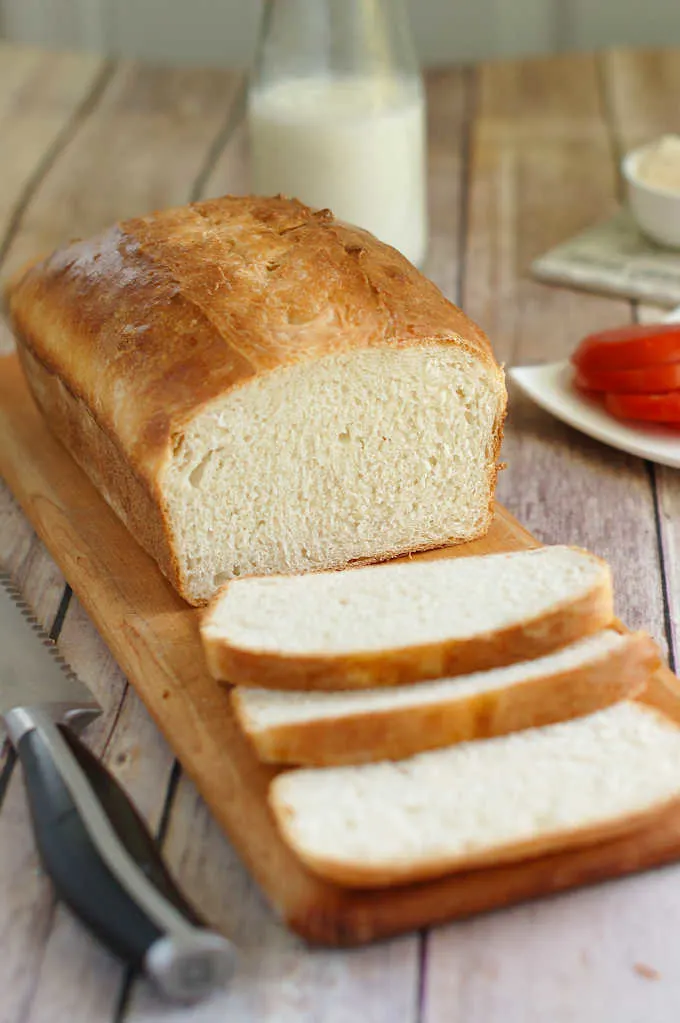
Table of contents
Why this is the best Sourdough Sandwich Bread
White Sandwich Bread doesn’t have to have the lackluster taste and squishy texture of a certain “wonderous” bread that many of us ate growing up. This sourdough sandwich bread has deep flavor, a beautiful texture and a soft crust.
Milk, butter and a whisper of sugar create a perfectly soft white bread that is ideal for making a great PB&J or BLT.
Although this recipe takes a good 8-12 hours from start to finish, the vast majority of the time is hands off.
To make this recipe even more convenient, you can let the dough rise over night. A long rise in the refrigerator does only good things for the bread.
If you don’t already have one, I can show you how to make a sourdough starter and how to feed a sourdough starter.
Ingredients

Ingredient Notes
- Sourdough Starter – This recipe was developed using 100% hydration starter. You will need to adjust the liquid or flour in the recipe if you’re starter isn’t at 100% hydration.
- All Purpose Flour – Medium protein AP flour makes a bread with a soft crumb yet develops enough gluten so the bread rises high in the oven.
- Milk – Scalding denatures (breaks down) proteins in the milk which can interfere with gluten development.
- Butter – A little fat softens the crumb of the bread.
- Salt – For flavor.
- Sugar – Enhances browning and make the crumb soft and slightly sweet.
How to make Sourdough Sandwich Bread with a soft crust
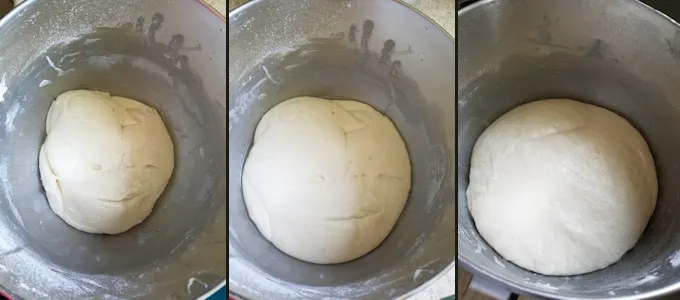
- Mix the dough and set it aside for the initial fermentation.
- With each hour of fermentation the dough will rise higher, become more active and more elastic.
- After the initial fermentation you can continue on to shape and bake the loaf, or you can refrigerate the dough overnight and continue the next day. A long, cool rest in the refrigerator enhances the flavor and texture of the dough.
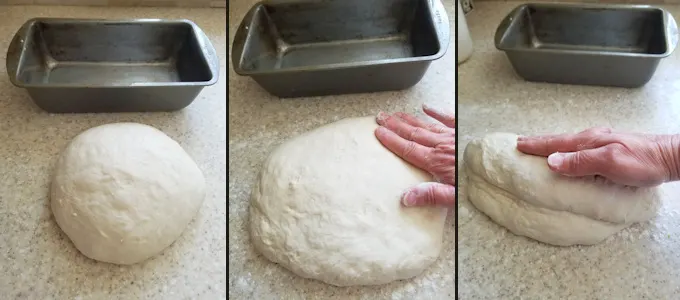
- Turn the dough out onto a lightly floured surface.
- Without kneading out the air, gently form the dough into a rectangle.
- Roll the rectangle into a log and set into a lightly greased loaf pan.
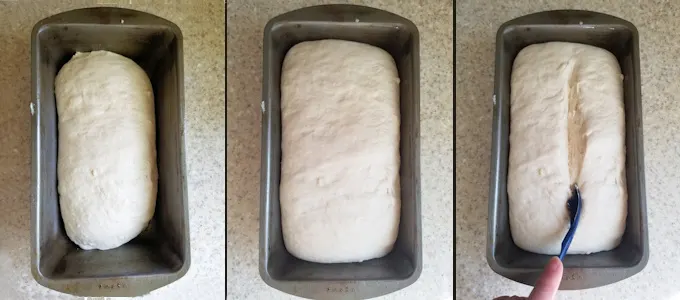
- Cover the pan and set the loaf aside to rise.
- The dough will expand to almost fill the pan.
- Slash the top of the loaf to promote even rising in the oven.
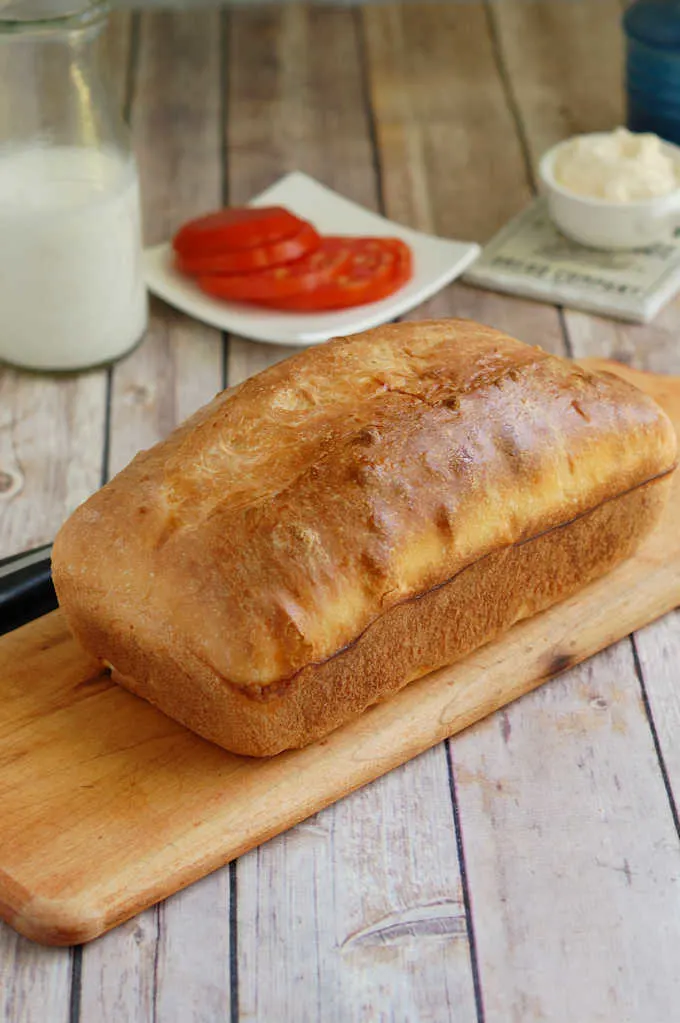
- Brush the loaf with egg wash and bake until the interior temperature is 200F.
- Cool the loaf completely before cutting.
A timeline for making Sourdough Sandwich Bread:
- If your starter needs feeding, do that the night before or early in the morning of the day you want to make the dough.
- Mix the dough in the afternoon, allow it to ferment for 3-4 hours then refrigerate the dough before going to bed.
- Take the dough out of the refrigerator first thing in the morning, shape the loaf and set it into the pan.
- To warm up the dough, turn on the oven just until it’s barely warm. Turn off the oven and set the pan with the cool dough in the oven. Remove the pan once the dough is back to room temperature. You can skip this step, but it does speed up the rising time.
- Leave the loaf to rise for 1 1/2- 2 hours, or as long as is needed to almost double in size.
- To make and bake the dough in the same day, feed your starter the evening before so it’s active by morning. Start the dough early in the morning and it should be ready to bake by late afternoon or early evening.
Storage
Sourdough Sandwich bread will keep at room temperature for 2-3 days. The bread (sliced or whole) can be frozen for up to a month.

I know you hate to throw away that sourdough discard. Check out these recipes that use sourdough discard.
More great sourdough breads
- Whole Wheat Sourdough Bread
- Sourdough Hoagie Rolls
- Sourdough Multigrain Bread
- Sourdough Semolina Bread
- Sourdough Rye Bread
- Crusty Sourdough Bread
If you love this recipe as much as I do, I’d really appreciate a star rating and a quick comment. Ratings and comments help my recipes show in search results. Thanks!
Sourdough Sandwich Bread Recipe
Ingredients
- 8 oz whole milk (1 cup)
- 1 oz unsalted butter
- 8 oz active sourdough starter (1 cup, 100% hydration)
- ½ oz granulated sugar (1 tablespoon)
- 1 ½ teaspoons salt
- 12 ½ oz all purpose flour (2 ½ cups, see note)
- 1 large egg (for egg wash)
Instructions
- Warm 8 oz whole milk in the microwave to until scalding hot (just before it comes to a boil.) Stir 1 oz unsalted butter into the warm milk to melt. Set the milk aside to cool until it's slightly warmer than body temp.
- In a mixer bowl, combine the warm milk with 8 oz active sourdough starter, ½ oz granulated sugar and 1 ½ teaspoons salt and stir to combine. Add 1 ½ cups of the flour and stir until the batter looks like thick pancake batter. If using a stand mixer, change to the dough hook.
- With the mixer running, slowly add the remaining flour until the dough gathers on the hook and clears the sides of the bowl. Knead for 5 minutes. If mixing by hand, stir in as much flour as you can then turn the dough out onto a floured surface and knead in the remaining flour.
- Remove the dough from the bowl onto a lightly floured surface. The dough should be soft and slightly sticky. Knead to form a smooth ball. If the dough is very sticky sprinkle a little more flour as you knead.
- Place the dough in an oiled bowl, turning once to coat the dough. Cover the bowl and set it aside at room temperature.
- After 60 minutes uncover the bowl, lift one side of the dough and fold it into the middle of the dough. Repeat with the other three sides of the dough then flip the dough over. You're basically turning the dough inside-out to redistribute the yeast and strengthen the gluten. Cover the bowl and after 60 minutes repeat the procedure.
- Cover the bowl and after 60 minutes fold the dough one more time. By now the dough should be lively, elastic and airy. If the dough is still sluggish give it another hour or two at room temperature. If you want to finish making the bread in the morning return the dough to the bowl, cover tightly and refrigerate overnight. The next morning continue with shaping. Otherwise continue shaping the loaf on the same day.
- Grease a 9"x 5" loaf pan with a very light film of vegetable oil.
- Turn the dough out onto a floured surface and without kneading out the air, gently push the dough to a 9" rectangle. Tightly roll the dough to form a log.
- Set the dough into the pan and cover with a damp kitchen towel or oiled plastic wrap. Set in a warm place and rise until the dough is doubled in size, about 1-1½hours.
- Preheat the oven to 350 °F. Use a sharp knife or razor to cut a 1/2" deep slash down the center of the loaf. Brush the loaf with egg wash.
- Bake about 30-35 minutes until golden brown and and a toothpick inserted in the center comes out clean. The interior temp should be 200 °F.
- Cool in the pan for 5 minutes before turning out onto a cooling rack. Finish cooling to room temperature before slicing,
Would you like to save this recipe?
As an Amazon Associate and member of other affiliate programs, I earn from qualifying purchases.








Can you leave the bread out overnight in the oven (off w light on) or counter, instead of the fridge? Then in the morning divide it in pans and bake? I doubled the recipe. Thanks!
If you want to leave it out overnight I would leave it in a cool spot. Also, mix the dough later in the day so it’s not out too long. You don’t want to exhaust the yeast by leaving it in a warmer spot. My kitchen tends to be quite cool in the winter and spring, so leaving it on the kitchen counter would be ok.
Hi, I have this in the bowl working on the ‘folding’ steps. I’m unsure how many times I need to fold it. Is it two times waiting 30 mins each and then two times waiting 60 mins each and then into the pan for 1 1/2 hrs (or so) then bake?
Thank you.
Yes, fold after 30 minutes, fold after 30 minutes, fold after 60 minutes and fold again after 60 minutes. That a total of four folds over 3 hours. But if you find after 3 hours the dough is not noticeably lively and aerated you can leave it another hour or two, or even more, at room temperature. The goal is to get a dough that is well aerated and cohesive. In chillier weather I’ll often mix the dough and leave it out in my kitchen all afternoon and evening then put it in the fridge before bed.
We don’t typically keep whole milk on hand, I’m wondering if 1% is a suitable substitute?
Yes, that would work too.
Hi Eileen,
After yesterday’s successful sourdough english muffin, I would love to try this recipe. With social distancing going on I’d rather use a milk powder to substitute whole milk. I read that I can substitute 1 cup whole milk to 1/3 cup of milk powder to 1 cup water. I will give you an update.
I made this yesterday, I followed all the instructions and left in the fridge to ferment overnight. First thing next morning, I took it out from the fridge, shape into loaf and put into a warm oven for an hour. Then put on top of the bench to rise on room temperature. After another 2 hours the dough didn’t rise at all.
So I decided to reshape again the loaf and waited for another 2 hours. The dough rose a little and I decided just to bake it. It turned out very fluffy but very flat. I don’t mind doing this again one day.
Hi Ann, With sourdough recipes we always have to be very flexible with the timing. How the dough rises depends quite a bit on how active your starter is, the temperature of the room and the temperature of the dough. If you find that after several hours of the initial fermentation (on day 1) that the dough is not lively and aerated just give it more time at room temperature. During the initial fermentation it’s almost impossible to leave it out too long (unless you go days, of course). Next time, if the shaped loaf is slow to rise I wouldn’t reshape it, I would just leave it in a warm spot until it kicks in. Please let me know if I can answer any other questions.
Thanks for the prompt response Eileen, appreciate that! Well, I noticed on day 1 that the dough rose and aerated properly especially next day before I shape it. How long can I leave the dough for the first rise? I got scared leaving it for more than 3 hours. Can I leave the dough inside the oven with lowest heat setting to rise? Sorry too many questions.
Anyway, I make bread and feed my starter once a week. I’ll leave my starter inside the fridge then took a starter to make bread at the same time feed and leave in room temperature for atleast 4 hours then put it back to the fridge.
I am planning to make this bread again. It’s been days but we can still taste the freshness of the bread unlike the store bought.
With all bread, not just sourdough, go more by how to dough looks and acts than by time. To check if a dough is ready for the oven, poke the dough with your finger. If it bounces right back it’s not quite ready, if the dimple remains and doesn’t fill in the dough is over-risen, if the dimple slowly fills-in the dough is ready for the oven. You can leave the dough in the oven if it’s not more than about 75-80 degrees F. Warmer than that won’t be good for the yeast. I use a similar schedule to feed by starter.
I put my bread from overnight in a warm oven following your directions. It was rising well. I then covered it with a damp dish towel to rise for the 1 1/2- 2 hours before baking. It seems to have deflated. When I tested by poking with my finger, the dent remains, so it must be over risen. You say, in the comments above that the loaf can be reshaped. What exactly do you mean and can I just leave the bread in the pan to rise more?
It sounds like the dough is over-risen. You can turn the dough out of the pan, knead it briefly, reshape it and return it to the pan to rise again. The timing is never exact with sourdough (or any yeast dough). So even if the recipe says 1 1/2- 2 hours you need to check it frequently since it will rise more quickly in a warmer room. As far as putting the bread in the oven, as I mention the oven should be barely warm and then turned off. “To warm up the dough, turn on the oven just until it’s barely warm. Turn off the oven and set the pan with the cool dough in the oven. Remove the pan once the dough is back to room temperature.”
Thanks. I’m looking forward to tasting.